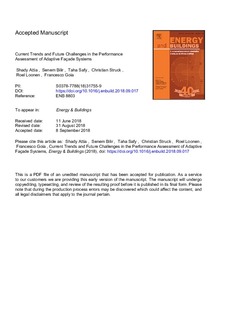| dc.contributor.author | Attia, Shady | |
| dc.contributor.author | Bilir, Senem | |
| dc.contributor.author | Safy, Taha | |
| dc.contributor.author | Struck, Christian | |
| dc.contributor.author | Loonen, Roel | |
| dc.contributor.author | Goia, Francesco | |
| dc.date.accessioned | 2018-09-27T07:39:09Z | |
| dc.date.available | 2018-09-27T07:39:09Z | |
| dc.date.created | 2018-09-26T09:41:35Z | |
| dc.date.issued | 2018 | |
| dc.identifier.citation | Energy and Buildings. 2018, 179 165-182. | nb_NO |
| dc.identifier.issn | 0378-7788 | |
| dc.identifier.uri | http://hdl.handle.net/11250/2564849 | |
| dc.description.abstract | During the last decades, a great number of innovative building envelope materials and façade components have been developed. The majority of these technologies promise significant improvements in energy efficiency and occupant's comfort, with products that are easily available in the market. However, it remains a challenge to assess the performance of such facades, leading to difficulties for efficient design, operation, and maintenance. As a consequence, the market adoption of adaptive facades is not realizing its full potential, resulting in missed opportunities for energy savings and improved occupant satisfaction. In this study, the current trends of adaptive facades are investigated, with particular emphasis on their performance assessment. Based on extensive literature review, the gaps in assessment of adaptive facades are determined and a novel object-based façade characterization and classification framework is proposed. Furthermore, a generic stakeholder map and process map are presented to explain current adaptive façade delivery practices. In addition, the findings of interviews and two focus group discussions with experts and specialists are presented to elucidate their expert opinions, leading to a validated framework of key performance indicators. As results of this paper, the gaps related to adaptive façade systems’ assessment are identified with respect to the different actors and stakeholders, and insights and perspectives on current trends and future challenges of adaptive façade system assessment are provided. | nb_NO |
| dc.language.iso | eng | nb_NO |
| dc.publisher | Elsevier | nb_NO |
| dc.rights | Attribution-NonCommercial-NoDerivatives 4.0 Internasjonal | * |
| dc.rights.uri | http://creativecommons.org/licenses/by-nc-nd/4.0/deed.no | * |
| dc.title | Current trends and future challenges in the performance assessment of adaptive façade systems | nb_NO |
| dc.type | Journal article | nb_NO |
| dc.type | Peer reviewed | nb_NO |
| dc.description.version | acceptedVersion | nb_NO |
| dc.source.pagenumber | 165-182 | nb_NO |
| dc.source.volume | 179 | nb_NO |
| dc.source.journal | Energy and Buildings | nb_NO |
| dc.identifier.doi | 10.1016/j.enbuild.2018.09.017 | |
| dc.identifier.cristin | 1613642 | |
| dc.relation.project | Norges forskningsråd: 255252 | nb_NO |
| dc.description.localcode | © 2018. This is the authors’ accepted and refereed manuscript to the article. Locked until 20.9.2020 due to copyright restrictions. This manuscript version is made available under the CC-BY-NC-ND 4.0 license http://creativecommons.org/licenses/by-nc-nd/4.0/ | nb_NO |
| cristin.unitcode | 194,61,55,0 | |
| cristin.unitname | Institutt for arkitektur og teknologi | |
| cristin.ispublished | true | |
| cristin.fulltext | preprint | |
| cristin.qualitycode | 2 | |

